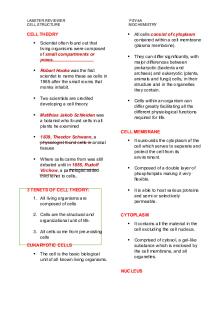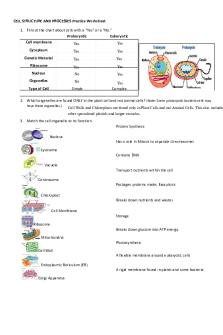Ultra structure of Animal cell PDF

| Title | Ultra structure of Animal cell |
|---|---|
| Author | jaya pawade |
| Course | Cell Biology |
| Institution | Sant Gadge Baba Amravati University |
| Pages | 3 |
| File Size | 134.2 KB |
| File Type | |
| Total Downloads | 20 |
| Total Views | 133 |
Summary
ultra structure of animal cell in cell biology...
Description
Ultra structure of Animal cell Animal cells are eukaryotic cells, the nucleus and other organelles of the cell are bound by membrane.
Cell membrane 1. It is a semi-permeable barrier, allowing only a few molecules to move across it. 2. An electron microscopic study of cell membrane shows the lipid bi-layer model of the plasma membrane, it also known as the fluid mosaic model. 3. The cell membrane is made up of phospholipids which has polar (hydrophilic) heads and nonpolar (hydrophobic) tails. Cytoplasm 1. The fluid matrix that fills the cell is the cytoplasm. 2. The cellular organelles are suspended in this matrix of the cytoplasm. 3. This matrix maintains the pressure of the cell, ensures the cell doesn't shrink or burst. Nucleus 1. Nucleus is the house for most of the cells genetic material- the DNA and RNA. 2. The nucleus is surrounded by a porous membrane known as the nuclear membrane. 3. The RNA moves in/out of the nucleus through these pores. 4. Proteins needed by the nucleus enter through the nuclear pores. 5. The RNA helps in protein synthesis through transcription process. 6. The nucleus controls the activity of the cell and is known as the control center. 7. The nucleolus is the dark spot in the nucleus, and it is the location for ribosome formation.
Ribosomes 1. Ribosomes are the site for protein synthesis where the translation of the RNA takes place. 2. As protein synthesis is very important to the cell, ribosomes are found in large number in all cells. 3. Ribosomes are found freely suspended in the cytoplasm and also are attached to the endoplasmic reticulum. Endoplasmic reticulum 1. ER is the transport system of the cell. It transports molecules that need certain changes and also molecules to their destination. 2. ER is of two types, rough and smooth. 3. ER bound to the ribosomes appears rough and is the rough endoplasmic reticulum; while the smooth ER does not have the ribosomes. Lysosomes 1. It is the digestive system of the cell. 2. They have digestive enzymes helps in breakdown the waste molecules and also help in detoxification of the cell. 3. If the lysosomes were not membrane bound the cell could not have used the destructive enzymes. Centrosomes 1. It is located near the nucleus of the cell and is known as the 'microtubule organizing center' of the cell. 2. Microtubules are made in the centrosome. 3. During mitosis the centrosome aids in dividing of the cell and moving of the chromosome to the opposite sides of the cell. Vacuoles 1. They are bound by single membrane and small organelles. 2. In many organisms vacuoles are storage organelles. 3. Vesicles are smaller vacuoles which function for transport in/out of the cell. Golgi bodies 1. Golgi bodies are the packaging center of the cell. 2. The Golgi bodies modify the molecules from the rough ER by dividing them into smaller units with membrane known as vesicles. 3. They are flattened stacks of membrane-bound sacs. Mitochondria 1. Mitochondria are the main energy source of the cell. 2. They are called the power house of the cell because energy (ATP) is created here. 3. Mitochondria consist of inner and outer membrane. 4. It is spherical or rod shaped organelle. 5. It is an organelle which is independent as it has its own hereditary material. Peroxisomes 1. Peroxisomes are single membrane bound organelle that contain oxidative enzymes that are digestive in function. 2. They help in digesting long chains of fatty acids and amino acids and help in synthesis of cholesterol. Cytoskeleton
1. 2. 3. 4. 5. 6.
It is the network of microtubules and microfilament fibres. They give structural support and maintain the shape of the cell. Cilia and Flagella Cilia and flagella are structurally identical structures. They are different based on the function they perform and their length. Cilia are short and are in large number per cell while flagella are longer and are fewer in number. 7. They are organelles of movement. 8. The flagellar motion is undulating and wave-like whereas the ciliary movement is power stroke and recovery stroke. Functions of the Animal Cell 1. Cell Nucleus - Cell nucleus is referred to as the control center of the cell. The genetic material of the organism is present in the cell. The replication of DNA and synthesis of RNA occurs in the nucleus of the cell. It also regulates the activities of the other cellular organelles. 2. Mitochondria - The mitochondria is referred to as the power house of the cell. Its main function if to produce energy for cell by the process of cellular respiration. The energy produced is ATP. 3. Endoplasmic Reticulum - It is a network for transportation of certain substances in and out of the nucleus. 4. Golgi apparatus - It is involved with processing and packaging of the molecules that are synthesized by the cells. The crude proteins that are passed on by the ER to the apparatus are developed by the Golgi apparatus into primary, secondary, and tertiary proteins. 5. Ribosomes - The function of ribosomes is protein synthesis. 6. Lysosomes - They are referred to as the suicide bags of the cell. They have digestive enzymes and are involved in clearing the unwanted waste materials from the cell. They also engulf damaged materials like the damaged cells, and invading microorganisms and digest food particles. 7. Vacuole - They are large storage organelles. They store excess food or water. 8. The animal cells perform variety of activities by the aid of the cellular organelles. These cells function as a unit and the cells together form tissues. A group goes tissues with similar function form an organ and a group of organ of specific function to perform becomes an organ system. Thus, the microscopic cells from the basic unit for the activities and coordination and help survival of the organism....
Similar Free PDFs

Ultra structure of Animal cell
- 3 Pages

Structure of generalized cell
- 2 Pages

CELL Structure OF Microorganisms
- 7 Pages

Cell Structure SE 1
- 3 Pages

Labster 1 cell structure
- 10 Pages

Cell Structure (reviewer)
- 7 Pages

Cell Structure Worksheet
- 1 Pages

Cell Structure notes
- 13 Pages

Cell Structure Practice
- 3 Pages

Prokaryotic Cell Structure
- 4 Pages

Cell Structure worksheet
- 3 Pages

Animal and plant cell lab
- 13 Pages

1.b Cell Structure Worksheet
- 1 Pages
Popular Institutions
- Tinajero National High School - Annex
- Politeknik Caltex Riau
- Yokohama City University
- SGT University
- University of Al-Qadisiyah
- Divine Word College of Vigan
- Techniek College Rotterdam
- Universidade de Santiago
- Universiti Teknologi MARA Cawangan Johor Kampus Pasir Gudang
- Poltekkes Kemenkes Yogyakarta
- Baguio City National High School
- Colegio san marcos
- preparatoria uno
- Centro de Bachillerato Tecnológico Industrial y de Servicios No. 107
- Dalian Maritime University
- Quang Trung Secondary School
- Colegio Tecnológico en Informática
- Corporación Regional de Educación Superior
- Grupo CEDVA
- Dar Al Uloom University
- Centro de Estudios Preuniversitarios de la Universidad Nacional de Ingeniería
- 上智大学
- Aakash International School, Nuna Majara
- San Felipe Neri Catholic School
- Kang Chiao International School - New Taipei City
- Misamis Occidental National High School
- Institución Educativa Escuela Normal Juan Ladrilleros
- Kolehiyo ng Pantukan
- Batanes State College
- Instituto Continental
- Sekolah Menengah Kejuruan Kesehatan Kaltara (Tarakan)
- Colegio de La Inmaculada Concepcion - Cebu


